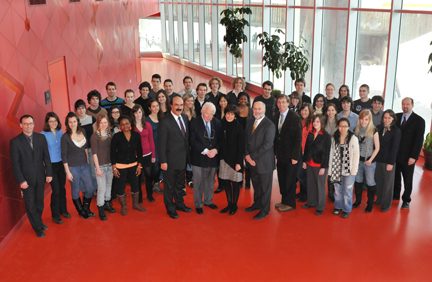Nouvelles
École Polytechnique de Montréal launches Canada's first bachelor's program in biomedical engineering
A bachelor's degree that scores high with students
Introduced for the 2008 fall session, this multidisciplinary program focusing on life sciences is attracting many female
students to engineering careers. The program, with a quota of students, now has 41 young people: 26 women and 15 men, meaning
that women represent 63% of the program's enrolment. By comparison, women currently comprise only 11.8% of members of the Ordre
des ingénieurs du Québec. It is worth emphasizing that the new bachelor's program is attracting high achievers: average college
R-scores is 32.8.

Here's what the first students have to say:
 "It's very exciting to be part of the first Canadian cohort to take such a program," says Alexe
Boudreau-Pinsonneault, a young woman who hopes to help improve the quality of people's lives and society's well-being in
general in a few years.
"It's very exciting to be part of the first Canadian cohort to take such a program," says Alexe
Boudreau-Pinsonneault, a young woman who hopes to help improve the quality of people's lives and society's well-being in
general in a few years.
"It's a very human specialty, and biomedical engineering innovation opens infinite possibilities," enthuses William Sanger, a passionate young man aiming for a career in research. He adds: "The bachelor's program is demanding but the courses are varied and inspiring. The integrative projects are a plus in our education. From the very first year, we have faced real engineering problems and we have had to learn to work in teams. We're a bit like pioneers; we have the opportunity to be part of an emerging discipline that is sparking original ideas."
What does a biomedical engineer do?
The difference between a biomedical engineer and a classically trained engineer is that the former can analyze problems from
the standpoint of both an engineer and a health professional. Biomedical engineers collaborate with professionals from other
disciplines, including doctors, biologists, therapists, administrators.
This new bachelor's degree will give students a solid grounding in biochemistry, cellular and molecular biology, physiology, mathematics, physics, chemistry, information technologies and engineering. In addition to the coursework, the program will include each year a project to integrate new knowledge and an obligatory four-month internship.
Where will Polytechnique's biomedical engineers work?
The multidisciplinary bachelor's program will
prepare students to tackle challenges in companies developing biomedical equipment, in the pharmaceutical and life sciences
sectors, in hospitals, engineering consultancies, university hospital research centres, government agencies and universities.
The training will also prepare them for higher studies in biomedical engineering or related disciplines, such as
medicine.
"This profession is relatively young and not well known, and Québec's industrial sector is just starting to emerge," says Professor Pierre Savard, who is in charge of the new bachelor's program. "Right now Québec has 350 small and medium-sized enterprises specializing in health technologies. It's still a modest industry, but exports are growing by 22% annually."
Adds Polytechnique CEO Christophe Guy: "With the planned construction of two new university hospital centres, the Greater Montréal region is developing into a remarkable growth centre for the life sciences industry and École Polytechnique de Montréal graduates will be playing a front-line role."
Polytechnique, a benchmark in biomedical engineering education
With some 20 highly reputed
professors in this field (including seven Canada Research Chairs and two NSERC Industrial Chairs), École Polytechnique is
breaking new ground in biomedical engineering studies: jointly with Université de Montréal, it has been offering master's
degrees since 1972 and doctorates since 1980.
"Some of our researchers or graduates have helped create new Québec enterprises devoted to the development of state-of-the-art diagnostic tools and treatments," notes Prof. Savard. "I'm thinking of, among others, Biorthex (orthopedic implants), Biosyntech (cartilage regeneration), Orthosoft (computer-assisted surgery), TomoVision (medical imaging), Y3D (movement analysis) and CryoCath (cardiac arrhythmia)."
Since 2000, Polytechnique has received grants totalling more than $63 million for the creation of research infrastructure and laboratories devoted to developing new biomedical applications.
A bit of history ...
Although the practice of biomedical engineering started over a century ago with the introduction of X-rays and
electrocardiography, it really took off in the 1960s with the development of the transistor and the computer, making
applications like the cardiac pacemaker, computerized axial tomography (CAT scans) and magnetic resonance imaging (MRIs)
possible.
Today, biomedical engineering brings together many specialties, from tissue engineering to orthopedic engineering, as well as bio-instrumentation. With the aging of the population and the constant need to increase the efficiency and effectiveness of health systems using technological innovation, the practice of biomedical engineering is evolving rapidly. Whether repairing cartilage, restoring sight, controlling bone growth to correct malformations, or targeting drug delivery to the body with nanometric precision, biomedical researchers and engineers are laying the foundations for a new, better-performing and less invasive medicine.
Polytechnique's first bachelors of biomedical engineering will reach the job market in 2012.




